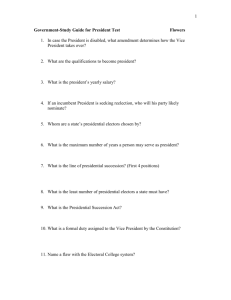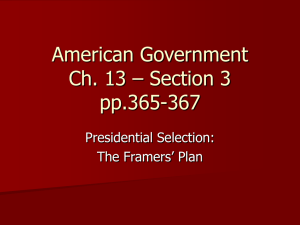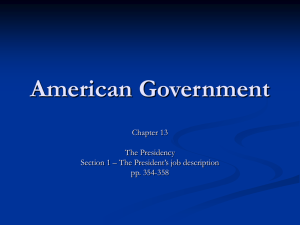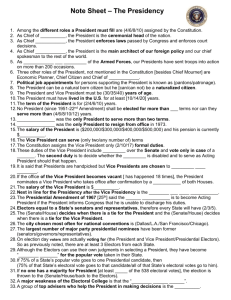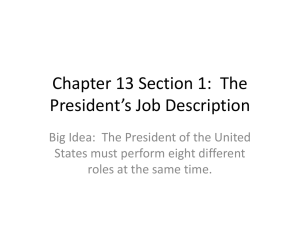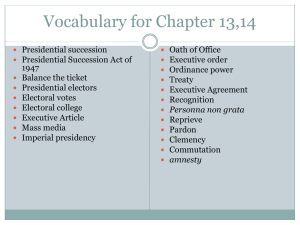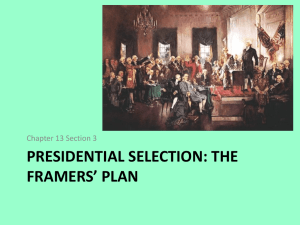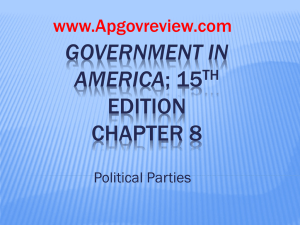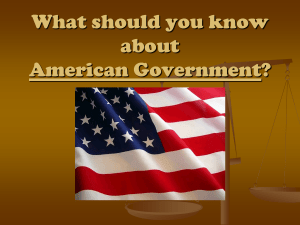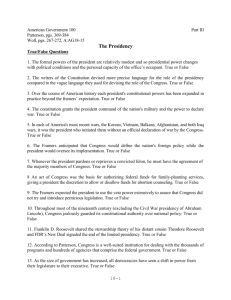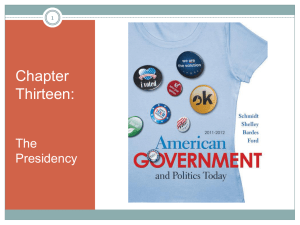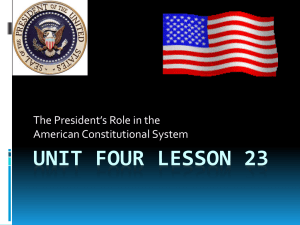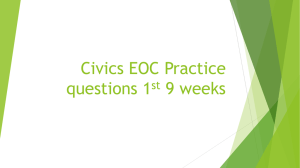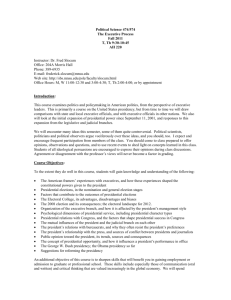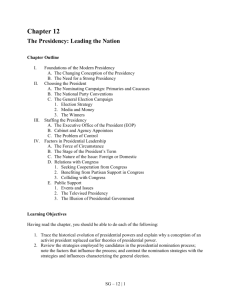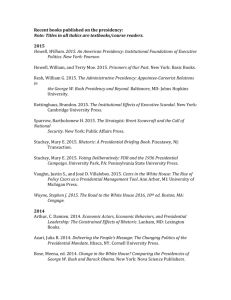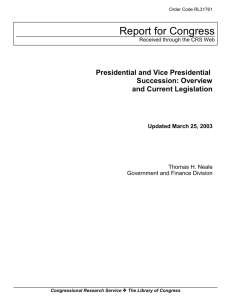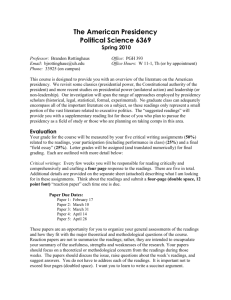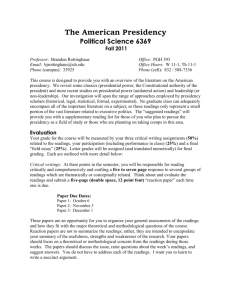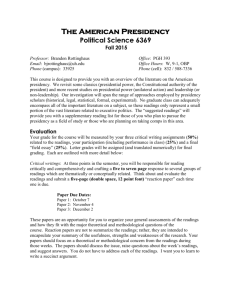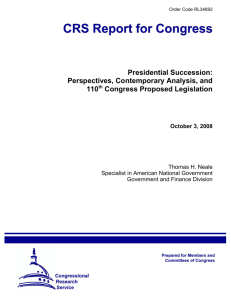Slide 1 - Garnet Valley School District
advertisement
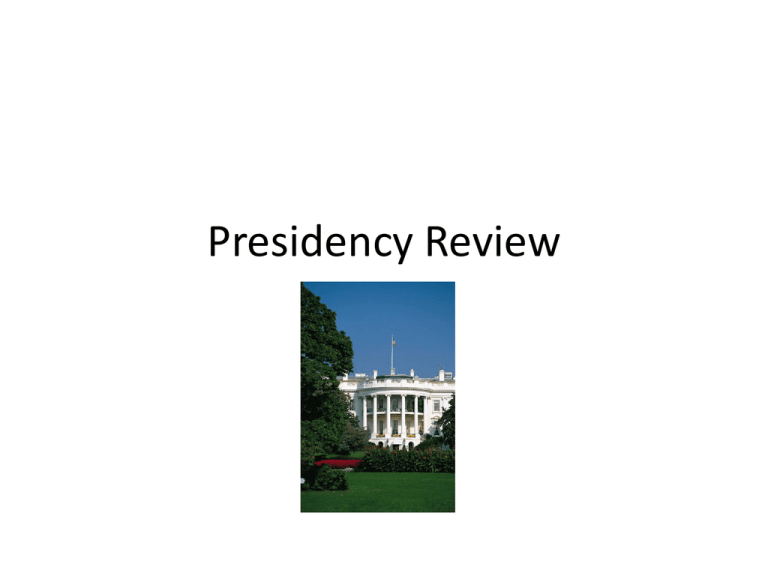
Presidency Review A formal statement of a political party’s basic principles 1. 2. 3. 4. Keynote address Platform Press Release Speech 25% 25% 25% 25% 1 2 3 4 How much does the President make per year? 1. 2. 3. 4. $400,000 $250,000 $200,000 $500,000 25% 25% 25% 25% 1 2 3 4 How are presidential electors chosen? 1. 2. 3. 4. State Legislators Popular Vote Congress At the National Convention 25% 25% 25% 25% 1 2 3 4 Which of the following is eligible to run for the presidency: a 45year old banker who was born and raised in Wyoming or a 30year-old State legislator who was born in Virginia, lived abroad for 10 years, then returned to Virginia? 1. 2. 3. 4. The banker The state legislator Neither a or b Both a and b 25% 25% 25% 25% 1 2 3 4 A president can serve no more than ___ years in office. 1. 2. 3. 4. 4 6 8 10 25% 25% 25% 25% 1 2 3 4 The President may decide to resume duties after an illness by informing Congress that no inability exists, but that decision can be challenged by 1. Vice President 2. Congress 3. The Vice President and the majority of the Cabinet 4. The Electoral College 25% 25% 25% 25% 1 2 3 4 In case the President is disabled, the way the Vice President becomes President is determined by the 1. Constitution 2. Presidential Succession Act 3. 25th Amendment 4. Congress 25% 25% 25% 25% 1 2 3 4 According to the Presidential Succession Act of 1947, which of these officers follows the Vice President in the line of presidential succession? 1. Speaker of the 100% House 2. President Pro Temp 3. Secretary of State 4. Secretary of Treasury 0% 1 2 0% 3 0% 4 During the nomination process, political battles are most likely to occur in 1. presidential primaries in the President's party. 2. presidential primaries in the party out of power. 3. The Electoral College. 9% 9% 83% 1 2 3 A formal duty of the Vice President 1. Call Cabinet meetings 2. Choose the Secretary of State 3. Preside over the House 4. Preside over the Senate 25% 25% 25% 25% 1 2 3 4 The Framers of the Constitution called for the President to be elected by 1. The House of Representatives 2. A body of electors 3. State legislators 4. Congress 25% 25% 25% 25% 1 2 3 4 The least number of presidential electors a State can have is 1. 2. 3. 4. One Two Three Four 65% 22% 13% 0% 1 2 3 4 The order of succession to the presidency after the Vice President is determined by the 1. original Constitution. 2. force of tradition. 3. Presidential Succession Act. 4. 25th Amendment. 0% 30% 0% 70% 1 2 3 4 The major importance of the 12th Amendment is that it 0% 1. did away with the electoral college system. 87%of a tie for the 2. eliminated the possibility presidency. 9% 3. required electors to pledge to vote for 4% their party's chosen candidate. 4. made electors' votes automatic. Most of the sessions at the national convention are spent 1. listening to the keynote address. 2. electing the convention's committee members. 3. selecting the party's presidential candidate. 4. listening to party speeches and reports. 9% 9% 43% 39% 1 2 3 4 The main argument in favor of limiting the President to a single 6-year term is that it would 1. limit the unprecedented power of the President. 2. permit more qualified people to serve as President. 3. free the President from the demands of a second-term campaign. 4. keep the President from being a "lame duck" in the second term. 32% 32% 5% 32% 1 2 3 4 The nation “played with fate” for nearly 180 years because 1. eight Presidents died in office. 2. the Presidential Succession Act had not yet been passed. 3. no constitutional or congressional provision defined presidential disability. 4. the President could not fire the Vice President. 4% 13% 48% 35% 1 2 3 4 The problem with the results of the election of 1796 was that 1. a Federalist captured the presidency. 2. a DemocraticRepublican captured the vice presidency. 3. the President and Vice President were from opposing parties. 4. two presidential candidates tied for the office. 0% 17% 0% 83% 1 2 3 4 If the winner of the popular vote does not win the presidency 1. the people must find another way to elect a President. 2. the will of the people has been subverted. 3. the election is thrown into the House of Representatives. 4. this proves that direct democracy would not work. 0% 13% 57% 30% 1 2 3 4 A candidate’s share of the popular vote is the basis for State’s electoral votes 1. 2. 3. 4. Balance the ticket Proportional plan Winner take all Swing voters 25% 25% 25% 25% 1 2 3 4 The president’s role as representative of all Americans. 1. 2. 3. 4. Chief of Party Commander-in-chief Chief Citizen Chief Administrator 25% 25% 25% 25% 1 2 3 4 Voters who are undecided 1. 2. 3. 4. Swing voters Party voters Primary voters Caucus voters 25% 25% 25% 25% 1 2 3 4 Who determines the President’s salary? 1. 2. 3. 4. Congress The people The President The Senate 25% 25% 25% 25% 1 2 3 4 When presidential electors are chosen “at-large” 1. They can vote for whomever they wish 2. They are chosen on a winner-take-all basis. 3. Their names appear on the ballot. 33% 33% 33% 1 2 3 If a presidential candidate does not gain the majority of electoral votes, the election is 1. Rescheduled 2. Decided by the House of Representatives 3. Decided by the Supreme Court 4. Decided by the State legislatures 25% 25% 25% 25% 1 2 3 4 The president’s role as head of the armed forces. 1. 2. 3. 4. Chief diplomat Commander in chief Chief of State Chief General 96% 4% 0% 1 2 3 0% 4 The speech given by an important party member at the first session of the national convention 1. 2. 3. 4. Opening speech Keynote address Presidential address Nominating speech 0% 100% 1 2 3 4
